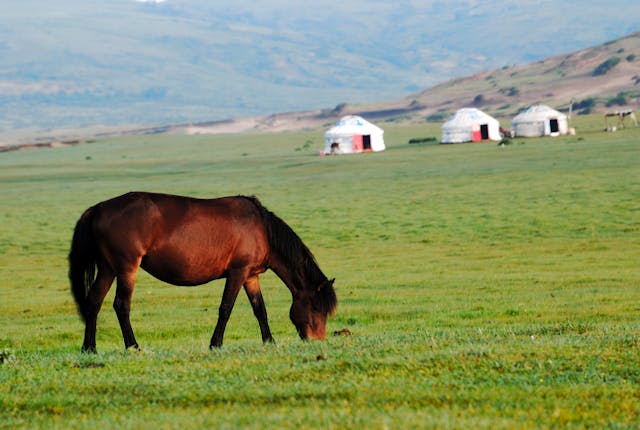
What is a steppe? A steppe is a dry, grassy plain that is found in a temperate climate. It is one of the many biomes on Earth.
The word “steppe” comes from the Russian word “step” (степь), which means low lying land. It came into English through German. In Russian, it us pronounced stjepj, and when it was written in the western alphabet, steppe was a close approximation. We have kept that spelling.
When we think about the steppe, we often think about the vast plains of Mongolia where Genghis Khan lived and started his empire, but steppes are found in other areas as well. A steppe is a fairly dry grassy plain located in a temperate climate. That puts it between the hot tropics and the cold polar regions of Earth. The summers tend to be hot, and the winters are usually cold. They are often in the center of large landmasses and experience continentality. They only get up to 50 cm of rain a year, and often a lot less. That is why they are grassy plains. There is enough rain to support short grass, but not enough water to support many other plants, and there are no trees. The grass is usually less than half a meter tall because there is not enough water to grow taller.
The largest steppe region is in central Eurasia, and it goes from China in the East all across to Hungary in the West. These are the plains where Genghis Khan grew up. This region is so large that it has even become known as The Steppe, which is why many people might think a steppe is a single place and not a biome. In fact, every continent has a steppe biome. In North America, the steppe region runs up the center of the USA and into lower Canada. In South America, the steppe region is in Argentina and Chile, at the bottom of the continent. In Africa, there is one that sweeps across the continent, to the south of the Sahara Desert, and another at the bottom of the continent, just above South Africa. And in Australia, it is mostly in the north of the country, just above the desert. In the USA, the steppe might be confused with the prairie, but they are slightly different. They have a similar climate and are in similar places, but the grasses in prairies are a little longer because they have slightly more rain than a steppe.
Steppes are remarkable biomes. They have low rainfall, so the ground can dry out. They are also very windy places because there are no trees to act as wind breaks. That means bare soil would be blown away very quickly. This is prevented by the short grass that has evolved to survive there. There are several types of grasses that grow on steppes, but they all have very long and very strong roots. These roots go down and help them to extract water from deep in the earth. They also anchor the grasses down so even strong winds can’t tear them up. This is great for the grasses, but it is also good for the soil because it keeps it in one place. The Dust Bowl that happened in the USA in the 1920s and 1930s is great proof of this. Farmers moved in and tried to cultivate the land. They ploughed up the grass (it was buffalo grass) in the US, and they planted wheat. Wheat doesn’t have the roots that grass does, and it didn’t survive. Once the grasses had gone, there was nothing to hold the soil down, and the wind picked it up. The Dust Bowl destroyed the economy of the region and even killed people. With hindsight, people could probably see there was a reason why the grass had been growing where it was.
Because there is so much grass, a lot of grazing animals live on steppe regions. Horses and buffalo are two good examples. The wild horses on The Steppe in Eurasia where tamed by the Mongols and helped them to become such fearsome riders and warriors. The buffalo lived on the American steppe and were hunted by the native Americans. The buffalo were all but wiped out by the American government in the 19th century when they are trying to defeat the native Americans. They killed millions of them. With conservation, they have started to return.
The steppe is a fascinating biome, but it is just one of all the biomes. According to Wikipedia, there are 26 biomes. Tropical rainforest, tropical seasonal rainforest, temperate giant rainforest, montane rainforest, temperate deciduous forest, temperate evergreen forest, subarctic-subalpine needle-leaved forests, elfin woodland, thorn forest, thorn scrub, temperate woodland, temperate shrublands, savanna, temperate grassland (this is the steppe), alpine grassland, tundra, tropical desert, warm-temperate desert, cool temperate desert scrub, arctic-alpine desert, bog, tropical fresh-water swamp forest, temperate fresh-water swamp forest, mangrove swamp, salt marsh, and wetland. Wow. And this is what I learned today.
Sources
https://en.wikipedia.org/wiki/Steppe
https://en.wikipedia.org/wiki/Biome
https://education.nationalgeographic.org/resource/steppe
https://science.howstuffworks.com/environmental/earth/steppe.htm
https://pages.ucsd.edu/~dkjordan/cgi-bin/moreabout.pl?tyimuh=steppe
https://www.etymonline.com/word/steppe
https://www.pmfias.com/steppe-climate-temperate-grassland-climate-temperate-continental-climate
https://animals.sandiegozoo.org/habitats/prairie-steppes
Photo by Lovesa Chang: https://www.pexels.com/photo/horse-grazing-on-mongolian-steppe-with-yurts-31427427/
